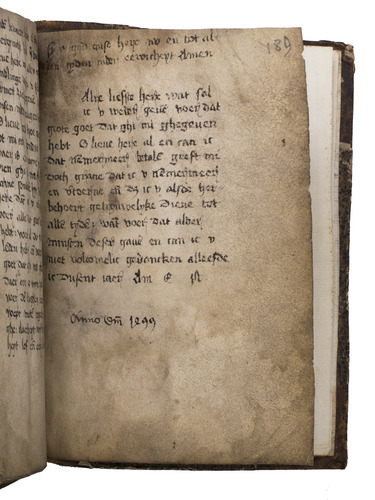[BOOK OF HOURS - DUTCH].
[15th-century manuscript book of hours, written in Middle Dutch]. [Incipit 1r:] Here du saltste op doen mine lippen en[de] mijn mo[n]t sal voert-kundige[n] dijn lof.
[Southern Netherlands, 15th century]. Small 4to (binding 15.5 x 12 cm; leaves ca. 14.5 x 11.5 cm). Manuscript in Middle-Dutch, written in one column (18 or 19 lines to a page) in a very neat gothic textura script, by one or maybe two hands. The vellum leaves are (lightly) ruled in red ink, the main body of the text is written in black ink. Leaf 1r shows a large 9-line painted initial (blue and white on a golden field) and elaborate green vines and blue, gold, and pink leaves in the margins, all tekst on 1r is written within a blue and gold frame. With 37 3- or 4-line painted initials (gold on a blue or pink field) with the same green, blue, gold, and pink vine-and-leaves decorations in the left margins of the leaves and 7 3-, 4-, or 5-line penwork initials (green, blue, and red) with simple red and green penwork decorations in the left margin of the leaves. Further with numerous 1- and 2-line red and blue initials throughout and occasional 6-line red or blue initials in the left margin of the leaves. 17th- or 18th-century gold- and blind-tooled half mottled calf and sprinkled paper sides, red sprinkled edges. [189] ll.
€ 18,000
Strikingly decorated and heigthened with gold 15th-century Dutch-language book of hours, from the collection of the noble Dutch-Belgian Van Aefferden family.
In the first quarter of the 15th century, the production of books of hours exploded. The success of the Devotio moderna, a religious movement started by Geert Grote in the Netherlands in the 14th century, largely generated the high demand for these books. This movement encouraged laymen to adjust their daily rhythm of prayer to the regular prayer of the cleric. Although books of hours show many variations, some texts are often present: the Hours of the Virgin, the Hours of the Cross, the Hours of the Holy Spirit, the Office of the Dead, the Seven penitential psalms, a litany and often a calendar and other prayers. The present manuscript is very clearly part of the popularisation of this genre of religious works by the Devotio Moderna - movement. Large parts of the text in the present manuscript follow the translation attributed to Geert Grote (here matched to the text in the 1940 annotated print edition of Het getijdenboek van Geert Grote) and more importantly, the present manuscript contains the so-called "Hours (or Office) of Eternal Wisdom" which does not appear in Latin books of hours and mainly appears in the area where the Congregation of Windesheim and Devotio Moderna-followers were active.
The work opens with a captivatingly beautiful decorated page, showing a large 9-line decorated blue intial on a field heightened in gold and abundant marginal decorations. Throughout the whole manuscript, beautifully decorated intials can be found, often also heightened in gold, together with delicate decorations consisting of green vines and blue, pink, and gold leaves in the margins. This style of manuscript decoration is quite typical in the 15th-century Low Countries (northwestern Europe), but the particular style of the margin decorations might point to a more southern place of production instead of somewhere in the Northern Netherlands. Lieftink, in his 1972 typescript assessment of the present manuscript (copy included), found the decorations to be in the "French style", which further supports the assumption that it was produced somewhere in the Dutch-speaking Southern Netherlands. Interestingly, on the recto of the last page a later scribe added a date: "Anno d[o]m[ini] 1499". We, together with Lieftink (1972), assume that the date must be 1499, even though it looks like it says "1299". The style of writing, decorating and the language of the text, and the appearance of the "Office of Eternal Wisdom", ascribed to Geert Grote (1340-1384) all point to a production date of sometime during the 15th century.
The manuscript in its present form was highly likely part of a larger manuscript book of hours. At the end of the 17th-century or beginning of the 18th-century, the work reached its final form when being bound in the present leather and paper binding. While most key parts of any 15th-century book of hours can be found in the present manuscript, the texts doe not appear in their regular (or common) order and upon closer inspection it becomes clear that parts of the text are missing. Nevertheless, it remains a beautiful example of a 15th-century Dutch-language beautifully decorated book of hours.
With 16th- or 17th-century(?) annotations (religious rhymes) in the margins of several leaves, probably written with metalpoint. The boards and spine are scuffed but otherwise the integrity of the binding remains very good. Internally somewhat dust-soiled, the last few leaves are somewhat browned. Occasionally the text is slightly faded, Lieftinck (1972) reckoned the vellum was not uniformly well-prepared for the writing, meaning the ink was not able to attach to the writing surface as well, the majority of the text remains clearly legible. Overall in good condition. A remarkable decorated and heightened with gold 15th-century manuscript book of hours. Typescript assessment of the manuscript "Getijdenboek van Vicomte Charles van Aefferden te Spa" by G.I. Lieftinck (1972).
Related Subjects:

































